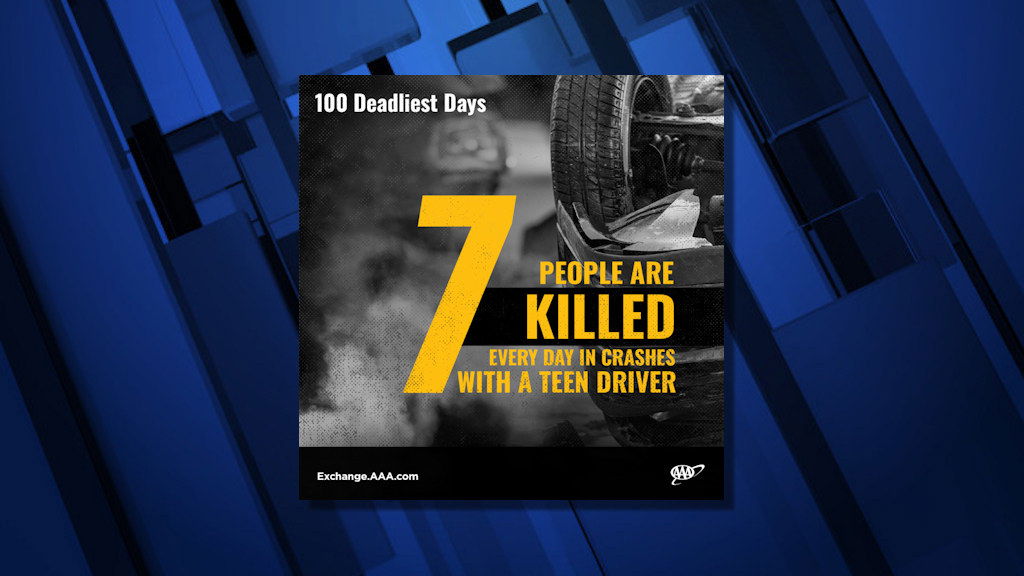Memorial Day marks the start of the ‘100 deadliest days’ for teen drivers, AAA Oregon/Idaho reports

PORTLAND, Ore., (KTVZ) – AAA finds that the 100 days between Memorial Day and Labor Day are when fatal crashes involving teen drivers rise.
Nationwide, 7,435 people died in summertime crashes involving teen drivers from 2013 through 2022. That’s seven people per day during these 100 days. That is nearly half of the total number of those killed in teen-driver crashes for the entire rest of the year. And in 2022 alone, 790 people were killed in these types of crashes – a 10% increase over pre-pandemic 2019.
In Oregon, 81 people died in crashes involving teen drivers during the “100 deadliest days” in this 10-year period. This is an average of eight people dying each summer, compared to an average of 17 deaths in crashes involving teen drivers during the rest of the year in Oregon. This is nearly half of the total number of those killed in teen-driver crashes for the rest of the year in Oregon.
In 2022, nine people were killed in crashes involving teen drivers in Oregon, the same as in 2021 and up from eight in 2020.
Find data here.
For 2022, Oregon ranks 35th in the country for most per-capita crash fatalities involving teen drivers with five deaths in crashes involving teen drivers per one million population. Find the complete list here.
Wyoming has the highest per-capita deaths in crashes involving teen drivers with 24 deaths in 2022. The District of Columbia had no deaths involving teen drivers in 2022.
“Fatal crashes involving teen drivers spike during the summer months because teen drivers often drive without adults in the vehicle as they meet up with friends, drive to jobs and head to summer destinations. Teens are at greater risk of crashing because they just don’t have a lot of experience behind the wheel,” says Marie Dodds, public affairs director for AAA Oregon/Idaho. “Having friends in the car with a teen driver increases the crash risk, according to previous research done by the AAA Foundation for Traffic Safety.”
“It’s important to note that people killed in these crashes are not always the teen driver, but it can be their passengers, drivers and passengers in other vehicles, bicyclists and/or pedestrians. Basically all road users are at risk,” adds Dodds.
According to the latest AAA Foundation Traffic Safety Culture Index, teen drivers aged 16-18 admitted to having engaged in at least one of the following risky behaviors in the past 30 days:
- Holding and talking on a cellphone (39%)
- Reading a text or email on a cellphone (38%)
- Manually texting or sending a text message or email (30%)
- Using technology that allows hands-free use of their phone (53%)
- Driving 15 mph over the speed limit on a freeway (39%)
- Driving 10 mph over the speed limit on a residential street (41%)
- Driving through a red light (28%)
- Aggressive driving (22%)
- Driving without wearing a seatbelt (13%)
- Driving while being so tired that they had a hard time keeping their eyes open (19%)
- Drinking enough alcohol that they may be over the legal limit (3%)
- Ridden in a car driven by someone who’s had too much alcohol (7%)
- Driving within an hour after using marijuana (5%)
- Driving after using potentially impairing prescription drugs (3%)
AAA has advice for parents:
Studies show that teen drivers become safer behind the wheel if they receive instruction by a trained professional and receive ongoing support and coaching from their parents. Visit AAA Exchange – Teen Driver Safety
- Talk with teens early and often about safe driving behaviors including wearing seatbelts, staying focused and complying with speed limits.
- Talk with teens about dangerous behaviors behind the wheel, such as speeding, impairment and distracted driving.
- Have your teen complete a comprehensive driver education course.
- Establish a parent-teen driving agreement that sets family rules for teen drivers.
- Have at least 50 hours of supervised practice driving with your teen.
- Take different routes, drive in different weather conditions, and take various types of roadways, such as neighborhood streets, urban areas, highways and freeways with your teens so they get experience in a wide variety of driving situations.
Parents also need to be good role models. Here’s what you should do whenever you’re driving with your teen in the car:
- Always wear your seat belt.
- Obey traffic laws.
- Don’t text while driving.
- Watch your speed.
- Don’t tailgate.
- Use your turn signals.
- Don’t drive when angry or tired.
“Parents are key in teaching their teens to be safe drivers. If you have a teenager at home, chances are they’ll roll their eyes at you when you talk to them. But they really do want to learn from their parents and they will often model your behavior behind the wheel. Set a good example for your teen driver. Teach them about the dangers of risky behaviors behind the wheel, including speeding, distracted and impaired driving, not wearing seatbelts, and aggressive driving,” says Dodds.